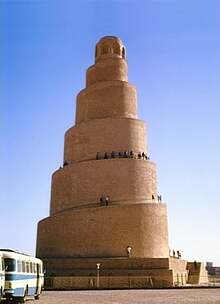Samarra (Arabic:سامَرّاء) is a city in Iraq's Baghdad Belts. In 2007, UNESCO named Samarra one of its World Heritage Sites.
Understand
[edit]
The region has been inhabited since prehistoric times and has given name to the Late Neolithic Samarra culture, which existed roughly between 5500 and 4800 BCE. The city of Sur-marrati was founded in 690 BC on the opposite bank of the Tigris. Since then the city has been destroyed and rebuilt several times and slightly different locations along the Tigris river.
Samarra in its current iteration was founded in 836 CE by the Abbasid Caliph Al-Mu'tasim. He and his successors built lavish palace complexes; such as al-Mutawakkiliyya, the Great Mosque of Samarra with its famous spiral minaret and the large palace Bulkuwara. Samarra remained the residence of the caliph until 892, when it returned to Baghdad. The city then declined and was largely abandoned starting in 940 CE. During the next millennia the city remained insignificant, but population increased during the 1950s when the Samarra Barrage was built and flooded nearby areas.
Today, Samarra is a city of about 350,000 inhabitants. Being the only remaining Islamic capital that retains its original plan, architecture and artistic relics it was named a UNESCO World Heritage Site in 2007.
Climate
[edit]- See also: Hot weather
Samarra has a hot desert climate. Daily highs in June and July easily reach 45 °C (113 °F).
Get in
[edit]By road
[edit]Highway 1 between Baghdad and Mosul passes by Samarra. The road is in acceptable condition, but robberies along the route have been frequent in the late 2010s.
By bus
[edit]There are daily buses from Baghdad.
By rail
[edit]National operator Iraqi Railways runs a passenger train from Baghdad once per week, on Fridays.
- 1 Samarra railway station (Western side of the river Tigris).
Get around
[edit]See
[edit]
- 1 Great Mosque of Samarra (مسجد سامراء الكبير). Ninth-century mosque that was commissioned in 848 and completed in 851 by the Abbasid caliph Al-Mutawakkil who reigned (in Samarra) from 847 until 861. Was at one time the largest mosque in the world; its minaret, the Malwiya Tower, is a vast spiralling cone 52 m high and 33 m wide with a spiral ramp. The art and architecture of the mosque was influential; stucco carvings within the mosque in floral and geometric designs represent early Islamic decoration.
- 2 Al-Askari Shrine (مرقد الامامين علي الهادي والحسن العسكري, Marqad al-Imāmayn ‘Alī l-Hādī wa l-Ħassan al-‘Askarī). Contains the mausoleums of the 'Ali al-Hadi and Hasan al-Askari, the tenth and eleventh Shia Imams, respectively, as well as the shrine of Muhammad al-Mahdi, known as the "Hidden Imam", who is the twelfth and final Imam of the Shia of the Ja'farī Madhhab. This has made it an important pilgrimage centre for Ja'farī Shia Muslims. In addition, Hakimah Khatun and Narjis Khatun, female relatives of the Prophet Mohammed and the Shia Imams, held in high esteem by Shia and Sunni Muslims, are buried there, making this mosque one of the most significant sites of worship for Shia and a venerated location for Sunni Muslims.
- 3 Qasr al-'Ashiq (قصر العاشق). A historical palace dates back to the Abbasid era, commissioned under the 15th Abbasid caliph Al-Mu'tamid. Construction took place during 877–882 and the palace is a prominent surviving example of the Abbasid architectural style.
- 4 Abu Dulaf Mosque (15 kilometres north of Samarra). Historic mosques commissioned by the 10th Abbasid Caliph Al-Mutawakkil in 859.
- 5 Belquara Palace (قصر بلكوارا).
- 6 Al-Barakah Palace (قصر البركة).
Do
[edit]Buy
[edit]Eat
[edit]Drink
[edit]Sleep
[edit]Stay safe
[edit]See the warning on the Iraq article for information on the security situation.


